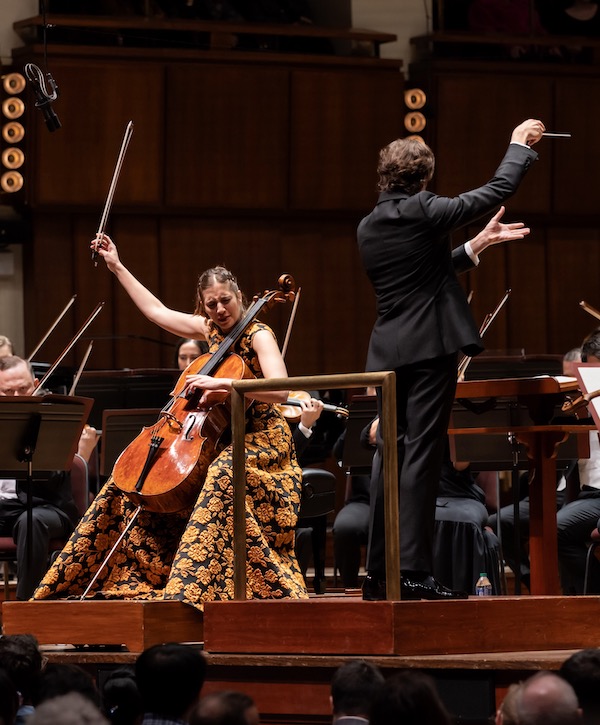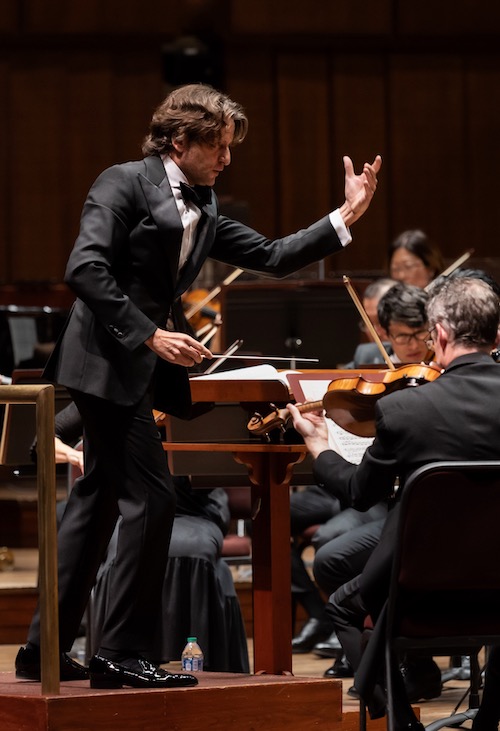Cellist Thomas makes strongest impression in NSO’s romantic program

Camille Thomas performed Elgar’s Cello Concerto with Gustavo Gimeno conducting the National Symphony Orchestra Thursday night at the Kennedy Center. Photo: Derek Baker
“My days are in the yellow leaf,” wrote Lord Byron at the ripe old age of 36, himself riffing on Shakespeare’s Macbeth. Gustavo Gimeno, music director of the Toronto Symphony Orchestra, led an autumnal program with the National Symphony Orchestra Thursday night in the Kennedy Center Concert Hall. All three works came near the end of their composers’ lives.
Of course, what we think of as life’s twilight has changed considerably over the years. Byron was not even halfway to the age of Cuban-American composer Tania León, who turned 80 this year. Not only did she write this new piece, Pasajes, co-commissioned by the NSO and premiered last year, but she bounded onto the stage to receive the accolades of the audience at the end of it. Gimeno’s energetic conducting seemed to amplify the work’s accrued effect.
In her notes about the piece, León signaled that the title means more than just passages of music, but something like transitions or passageways. Opening with high-set violins undergirded by violas, the piece cycled through its large instrumentation like a set of variations or a concerto for orchestra, featuring different groups in succession. The first section for strings unfolded serenely, with slowly evolving changes in the manner of Morton Feldman.
Woodwinds entered next, activated by piano and harp, with many relying on flutter-tonguing to give an unusual edge to the sound. Brass, also flutter-tongued, came into the mix next, followed by the percussion. A surprise cadenza for timpani, played with panache by acting principal Scott Christian, led to the upbeat conclusion, rippling with trumpet fanfares and a loud battery of drums and other percussion. While perhaps not a masterpiece, León’s new work kep the attention and diverted the ear over its twelve minutes, with inventive shifts of texture and instrumentation.
Edward Elgar penned his Cello Concerto in his 60s, and its mournful nostalgic character may also be related to the timing of its 1919 premiere, just after the ruin of World War I. It would be his last major work, as he lost his creative energy after the death of his wife the following year.
Franco-Belgian cellist Camille Thomas made a noteworthy NSO debut in the solo part, playing from memory. Her oaky, resonant tone stood out boldly from the orchestra, with resonant power on the multi-stop opening chords, a sobbing quality on that plangent first theme, and brash, searing vitality on the virtuoso rising scale up to high E that brought in the loud orchestral response. She was generous with romantic seasoning, lingering over rubato and making extravagant portamenti between notes, on her 1730 “Feuermann” Stradivarius.
In the scattershot second movement, she displayed a similar rhythmic freedom in the introduction and then darted off on the playful repeated-note main theme. Her interpretation of the aching slow movement was a little too rushed and impulsive to make maximum impact, partly her doing and partly from the impatience of Gimeno, in a shortcoming also noted at his last NSO appearance in 2017.
Thomas had her finest moment in the cadenza that opened the Finale, pensive and free in pacing. The concluding rondo was so fast that the section in sixteenth notes felt harried, but as some of the more introspective music from earlier in the concerto reappeared, Thomas took control in some sublime quiet moments. Her encore proved the highlight of the evening, a serene rendition of the Pablo Casals arrangement of the Catalan folk song “El cant dels ocells,” which the cellist played for President Kennedy at the White House.

Gustavo Gimeno conducted the NSO in music of Elgar, Brahms, and Tania León Thursday night. Photo: Derek Baker
Brahms premiered the Fourth Symphony, which would be his last, in 1885. He was only in his early 50s, but the sense of mortality reportedly weighed heavily on his mind. Gimeno’s rash approach did not serve the work well, as the tempo of the first movement fluctuated, often too fast in pacing. The second movement fared best, shaped expressively and fluidly by Gimeno from the opening Phrygian theme in the horns, with thoroughly mellow results.
The third movement came off more hectic than playful, in spite of those surprising triangle rolls, the only time Brahms ever used that instrument in a symphony. Here Gimeno’s preference for edgy tempos almost backfired, as the ensemble felt a little insecure. The Finale, a learned passacaglia with a wink, should have more of a sacred feel, based as it is on a bass line from a Bach cantata and with three trombones added for liturgical solemnity.
_________
In his masterful analysis of the Fourth Symphony, Brahms biographer Jan Swafford noted that composers after Brahms began to see the finale of this symphony, which ends most unusually in the minor mode, as a “taking back” of the optimistic ending of Beethoven’s Ninth. Brahms gave us, in Swafford’s words, “a progression from a troubling twilight to a dark night,” making this piece “his dark answer and counterpart to Beethoven’s joy.”
Swafford even notes that in one of the last pieces he wrote, in 1896, Brahms set the first four notes of this symphony’s sighing main theme (B-G-E-C) to the words “O death, o death.” Once you learn that fact, it is hard to hear the Fourth Symphony’s first movement without thinking of that as its unsung text.
The program will be repeated 11:30 a.m. Friday and 8 p.m. Saturday. kennedy-center.org

Posted Nov 03, 2023 at 9:16 pm by Adam T
I attended this last night. I was devastated by the extremely fast pace of the fourth movement of the Brahms. The conductor did little to bring out the richness of the symphony. It was on full blast, and I felt there was a moment or two where the whole thing nearly fell apart. Very disappointing considering how well known this work is.